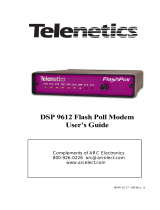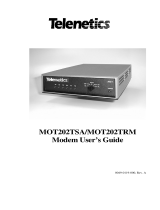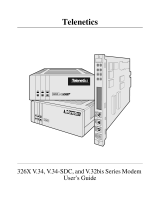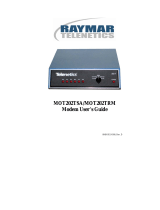Page is loading ...

¤
DSP9612RM Flash Poll
Rack-Mount Modem
User’s Guide
0049
−
0519
−
000 Rev. A
ARC Electronics 800-926-0226 www.arcelect.com

Compliances
This device complies with Part 15A of the FCC Rules. Operation is subject to
the following two conditions: (1) this device may not cause harmful
interference, and (2) this device must accept any interference received,
including interference that may cause undesired operation.
This equipment has been tested and found to comply with the limits for a Class
A digital device, pursuant to Part 15A of the FCC Rules. These limits are
designed to provide reasonable protection against harmful interference in a
residential installation. This equipment generates, uses, and can radiate radio
frequency energy and, if not installed and used in accordance with the
instructions, may cause harmful interference to radio communications.
However, there is no guarantee that interference will not occur in a particular
installation. If this equipment does cause harmful interference to radio or
television reception, which can be determined by turning the equipment off and
on, the user is encouraged to try to correct the interference by one or more of
the following measures:
c
Reorient or relocate the receiving antenna.
c
Increase the separation between the equipment and the receiver.
c
Connect the equipment to an outlet on a circuit other than the one to
which the receiver is connected.
c
Consult the dealer or an experienced radio/TV technician for help.
If none of these actions resolves the problem, consult your distributor or an
experienced radio/television technician for additional suggestions.
Additionally, Section 15.838, paragraph d), of the FCC Rules and Regulations
states: “Where special accessories, such as shielded cables, are required in
order to meet FCC regulations, shielded cables must be used with this
equipment. Operation with non-approved equipment or unshielded cables is
likely to result in interference to radio and TV reception. The user is cautioned
that changes and modifications to this equipment without the approval of the
manufacturer could void the user’s authority to operate this equipment.

Page iii
Contents
CHAPTER 1 INTRODUCTION
................................
.........................
5
F
EATURES
................................
................................
................................
6
A
PPLICATIONS
................................
................................
.........................
7
A
NCILLARY
D
OCUMENTATION
................................
................................
7
CHAPTER 2 INSTALLATION
................................
..........................
9
U
NPACKING
Y
OUR
H
ARDWARE
................................
...............................
9
A
DDITIONAL
I
TEMS
Y
OU
N
EED
................................
...............................
9
H
ARDWARE
O
VERVIEW
................................
................................
.........
10
Front View
................................
................................
.........................
10
Component View
................................
................................
...............
11
I
NSTALLATION
S
UMMARY
................................
................................
.....
12
C
ONFIGURING THE
M
ODEM
................................
................................
...
12
High-Speed (Fast Poll) Mode
................................
...........................
12
Low-Speed (FSK) Mode
................................
................................
....
18
I
NSTALLING THE
M
ODEM IN THE
U
NIVERSAL
D
ATA
S
HELF
...................
23
C
ONNECTING TO A
T
RANSMISSION
L
INE
................................
................
25
Modular Jack Connectors
................................
................................
.
25
Mass Termination Connector
................................
............................
26
C
ONNECTING AN
RS-232 D
EVICE
................................
..........................
26
LED
S
................................
................................
................................
.....
27
L
OOPBACK
C
ONTROL
S
WITCH
................................
...............................
28
APPENDIX A, TROUBLESHOOTING
................................
...........
29
P
ROBLEM
S
OLVING
................................
................................
................
29
APPENDIX B, SPECIFICATIONS
................................
..................
31
G
ENERAL
S
PECIFICATIONS
................................
................................
....
31
M
ECHANICAL
S
PECIFICATIONS
................................
..............................
32
B
ACK
-
TO
-B
ACK
C
ONNECTIONS TO A
S
ECOND
M
ODEM
.........................
33
RS-232 (RTU) Interface
................................
................................
....
33
E
NVIRONMENTAL
S
PECIFICATIONS
................................
........................
34
C
OMPLIANCES
................................
................................
........................
34
APPENDIX C, LIMITED PRODUCT WARRANTY
.....................
35
APPENDIX D, RMA PROCEDURE
................................
................
36

Contents
Page iv
N
OTES

Page 5
Chapter 1
Introduction
ongratulations for purchasing the finest industrial-grade fast-
poll rack-mount modem available.
The Telenetics DSP9612RM (Flash Poll) modem is a
9600/4800/0-1800 bps rack-mount modem designed for 4-wire, full-
duplex or 2-wire, half-duplex operation over a voice-band leased line.
The modem is designed utilizing the latest digital-signal processing
(DSP) technology to achieve high performance. The modem employs
Telenetics’ proprietary modulation and encoding scheme to achieve fast
modem training time. It is also backward compatible with Bell 202
modems.
The modem can be installed in either a Telenetics or a Motorola/UDS
RM16M Universal Data Shelf
. The modem occupies only one rack
slot, eliminating the hassle of equipment trays and power bricks
required for “Plastic Box” modems. The modem is powered from the
Universal Data Shelf.
The DSP9612RM modem is ideally suited for multi-point
communication systems that require fast response time, short training
time, and low throughput delay. The DSP9612RM is the most
technologically advanced rack-mount modem on the market.
This User’s Guide is designed to let you get your modem “up and
running” as quickly as possible. It contains all the information you need
to install and configure your modem. It also contains troubleshooting
information in the unlikely event you encounter a problem with your
modem.
C

Introduction
Page
6
Features
Though functionally similar to commercial modems, the DSP9612RM
provides the following unique features that make it well suited for
utility and industrial applications.
c
Requires only one rack slot in a Telenetics or a Motorola/UDS
RM16M Universal Data Shelf.
c
Operates over voice-band conditioned or unconditioned leased line
and pilot wires.
c
Operates without human intervention, making it ideal for
unmanned locations.
c
Works within an extended temperature range of -40ºC to +85ºC.
c
Designed with coupling transformers for high-voltage isolation and
common mode noise rejection in industrial and commercial
environments.
c
Asynchronous data rates (selectable) of 9600, 4800, and 0-1800
bps.
c
Easily accessible DIP switches for user configuration and option
selection.
c
Local analog, local digital, and remote digital loopback
diagnostics.

Applications
Page
7
Applications
The DSP9612RM modem is designed for point-to-point and multipoint
data communications. Figure 1-1 shows a typical multipoint
configuration.
Figure 1-1. Network of Multipoint Configuration
There are a number of factors that can affect the network’s and
modem’s operation and performance. These include:
c
Operating speed
c
2-wire or 4-wire configuration
c
Transmission line characteristics, noise, and line impairments
c
Network configuration (point-to-point or multipoint)
c
Number of nodes on the network
Ancillary Documentation
For information about the Telenetics RM16M Universal Data Shelf,
refer to the Telenetics RM16M Installation and Operation Manual for
the Universal Data Shelf version you have.

Introduction
Page
8
N
OTES

Page 9
Chapter 2
Installation
his chapter describes how to install the modem.
Unpacking Your Hardware
Your package should include:
c
At least one DSP9612RM modem
c
This User’s Guide
If your package contents are damaged or missing, please contact your
place of purchase immediately.
Additional Items You Need
To use your modem, you need the following additional items:
c
A Telenetics or Motorola/UDS RM16M Universal Data Shelf
c
A two- or four-wire transmission line or leased line
T

Installation
Page
10
Hardware Overview
Front View
Figure 2-1 shows a front view of the DSP9612RM modem. Starting
from the top, this view shows:
c
A loopback test switch. See page 28.
c
A set of eight LEDs. See page 27.
Figure 2-1. Front View of Modem

Hardware Overview
Page
11
Component View
Figure 2-2 shows the component view of the modem. This view shows:
c
Two configuration switch blocks, designated
SW1
and
SW2
. See
page 12.
c
Jumpers located in various positions on the modem. Do not change
or remove the straps from these jumpers.
c
Edge connectors at the back of the modem, which plug into the
backplane of a Telenetics or Motorola/UDS RM 16M Universal
Data Shelf.
Figure 2-2. Component View of Modem
Edge Connectors
Configuration
Switch Blocks
Switch Block SW2
Switch Block SW1

Installation
Page
12
Installation Summary
The modem installation involves the following steps:
1.
Configuring the modem. See the section below.
2.
Connecting to a transmission line. See page 25.
3.
Connecting an RS-232 device. See page 26.
Configuring the Modem
You configure the modem using the two sets of DIP switches on the
component side of the modem, near the center. The switches can have
one of two functions, depending on how switch SW2-1 is set.
c
Setting switch SW2-1 to OFF configures the modem for high-
speed (Fast Poll) mode. In this mode, the switches correspond to
the functions in Table 2-1 (see page 13).
c
Setting switch SW2-1 to ON configures the modem for low-speed
(FSK) mode. In this mode, the switches correspond to the functions
in Table 2-3 (see page 18).
Note:
The modem has several jumpers. Do not change or remove the
straps from the jumpers.
High-Speed (Fast Poll) Mode
Table 2-1 shows the modem switch settings that can be used when the
modem is configured for high-speed (Fast Poll) mode. This mode is
enabled when switch SW2-1 is set to OFF. Following this table is an
explanation of these settings.

Configuring the Modem
Page
13
Table 2-1. Modem Switch Settings for High-Speed Mode
Switch SettingsSwitches
ON OFF (Default)
SW 1-1
−
1-4: Transmit Level (page 14)
(see Table 2-2 on page 14)
SW 1-5: Receiver Dynamic Range
(page 15)
−
10 to
−
43 dBm +3 to
−
30 dBm
SW 1-6: TX Cable Equalizer (page 15) Enabled Disabled
SW 1-7: RX Cable Equalizer (page 15) Enabled Disabled
SW 1-8: Anti-streaming (page 15) Active Inactive
SW 2-1: High-Speed/Low-Speed Mode
(page 16)
Low-Speed Mode
(FSK)
High-Speed Mode
(Fast Poll)
SW 2-2: Data Rate in Fast Poll Mode 4800 bps 9600 bps
SW 2-3: Async Character 11 bits 10 bits
SW 2-4: Auto RTS (page 16) Enabled Disabled
SW2-5: Reserved
SW 2-6: Production Test Only (page 16)
Test Normal
SW 2-7: 2- or 4-wire (page 16) 2-wire, half-
duplex
4-wire, full-duplex
SW 2-8: Carrier Control (page 17) Constant Switched
SW 2-9: Rx Termination (page17) Disabled Enabled
SW 2-10: Ground Options (page 17) Chassis Ground-
Signal Ground
Connected
Chassis Ground-
Signal Ground
Disconnected

Installation
Page
14
SW1-1 through SW1-4
−
Transmit Level (high- & low-speed modes)
Switches SW1-1 through SW1-4 adjust the modem’s transmit level.
Table 2-2 shows the transmit levels you can select using these switches.
Table 2-2. Transmit Levels (High-Speed and Low-Speed Modes)
SW1 through SW4 Switch Settings
Transmit Level
SW1-1 SW1-2 SW1-3 SW1-4
0 dBm OFF OFF OFF OFF
−
1 dBm
OFF OFF OFF ON
−
2 dBm
OFF OFF ON OFF
−
3 dBm
OFF OFF ON ON
−
4 dBm
OFF ON OFF OFF
−
5 dBm
OFF ON OFF ON
−
6 dBm
OFF ON ON OFF
−
7 dBm
OFF ON ON ON
−
8 dBm
ON OFF OFF OFF
−
9 dBm
ON OFF OFF ON
−
10 dBm
ON OFF ON OFF
−
11 dBm
ON OFF ON ON
−
12 dBm
ON ON OFF OFF
−
13 dBm
ON ON OFF ON
−
14 dBm
ON ON ON OFF
+3 dBm ON ON ON ON

Configuring the Modem
Page
15
SW1-5
−
Receiver Dynamic Range (high- & low-speed modes)
SW1-5
ON =
−
10 to
−
43 dBm
OFF = +3 to
−
30 dBm
For a low receive signal level, set SW1-5 to ON (
−
43 dBm ). For short
distances or to select a strong receive signal, set SW1-5 to OFF.
SW1-6 and SW1-7
−
Cable Equalizer (high-speed mode only)
SW1-6 ON = Enable TX Cable Equalizer
OFF = Disable TX Cable Equalizer
SW1-7 ON = Enable RX Cable Equalizer
OFF = Disable RX Cable Equalizer
To improve or extend the modem’s polling performance, use the fixed
Compromise Cable Equalizer when polling on long metallic circuits.
The cable equalizer is active only when the modem is in high-speed
mode (SW2-1 set to OFF).
SW1-8
−
Anti-streaming (high- & low-speed modes)
SW1-8 ON = Anti-streaming active
OFF = Anti-stream inactive
Typically, anti-streaming is used in multi-point applications to prevent
a malfunctioning slave modem from occupying the line indefinitely.
When anti-streaming is active, the modem can transmit data for a
maximum of 27 seconds before the transmitter turns off automatically.
The modem then looks for an ON-to-OFF Request To Send (RTS)
transition before proceeding with normal operation. Anti-streaming can
be selected in either high-speed or low-speed mode.

Installation
Page
16
SW2-1
−
Fast Poll/FSK (high- & low-speed modes)
SW2-1 ON = Low-Speed Mode (FSK)
OFF = High-Speed Mode (Fast Poll)
SW2-1 configures the modem for either low-speed (FSK) mode or
high-speed (Fast Poll) mode. As a result, the SW2-1 setting you choose
determines the switch definitions for the other switches.
c
For high-speed mode, the configuration switches follow the
definitions in Table 2-1.
c
For low-speed mode, the configuration switches follow the
definitions in Table 2-3.
SW2-4
−
Auto RTS (high-speed mode only)
SW2-4 ON = Enable Auto RTS
OFF = Disable Auto RTS
For data terminals that do not support hardware RTS, set SW2-4 to ON
to enable buffer mode. In this mode, TXD is detected at the modem and
internal RTS is turned ON. After training completes, the TXD is
transmitted to the remote modem. The transmitter turns off if no TXD is
detected after 1 character length of idle time.
SW2-6
−
Production Test Only (high- & low-speed modes)
SW2-6 Must be OFF
SW2-6 must be in the OFF position for normal operation.
SW2-7
−
2-/4-Wire Operation (high- & low-speed modes)
SW2-7 ON = 2-Wire, Half-Duplex Mode
OFF = 4-Wire, Full-Duplex Mode
SW2-7 configures the modem for 4-wire full-duplex or 2-wire half-
duplex operation.

Configuring the Modem
Page
17
SW2-8
−
Carrier Control (high- & low-speed modes)
SW2-8 ON = Constant
OFF = Switched
SW2-8 selects either constant or switched carrier. Constant carrier
allows DTEs, such as asynchronous dumb terminals or RTUs, to
operate with modems, without the input RTS signal. When constant
carrier mode is enabled (SW2-8 set to ON), the modem forces the
transmit carrier active and the RTS-CTS delay is minimum (<0.5 ms.).
You can use constant carrier in 4-wire, point-to-point or multi-point
applications (from master to slave modems).
In switched-carrier mode (SW2-8 set to OFF), the RTS/CTS delay is 23
ms.
SW 2-9
−
RX Termination (high- & low-speed modes)
SW2-9 ON = Disable Rx Termination
OFF = Enable Rx termination
SW2-9 selects whether RX termination is enabled for a modem. If you
set this switch OFF, the receiver is terminated with 600
Ω
. If you set
this switch ON, the receiver is not terminated.
SW 2-10
−
Ground Option (high- & low-speed modes)
SW2-10
ON = Modem signal ground is connected to chassis ground
OFF = Modem signal ground and chassis ground
disconnected
SW2-10 determines the grounding option for the modem. Setting this
switch ON connects the modem signal ground to chassis ground.
Setting this switch OFF disconnects the modem signal ground from
chassis ground.

Installation
Page
18
Low-Speed (FSK) Mode
Table 2-3 shows the modem switch settings that can be used when the
modem is configured for low-speed (FSK) mode. This mode is enabled
when switch SW2-1 is set to ON. Following this table is an explanation
of these settings.
Table 2-3. Modem Switch Settings for Low-Speed Mode
Switch SettingsSwitches
ON OFF
SW 1-1
−
1-4: Transmit Level
(page 19)
(see Table 2-4 page 19)
SW 1-5: Receiver Dynamic Range
(page 20)
−
10 to
−
43 dBm +3 to
−
30 dBm
SW 1-6
−
SW1-7: RTS-CTS Delay
(page 20)
(see Table 2-5 page 20)
SW 1-8: Anti-streaming (page 20) Active Inactive
SW 2-1: High-Speed)/Low-Speed
Mode (page 21)
Low-Speed (FSK)
Mode
High-Speed
(Fast Poll) Mode
SW 2-2: CD Delay (page 21) 23 ms. 6 ms.
SW 2-3: Turnaround SQ (page 21) 0 ms. 8 ms.
SW 2-4: Not Used
SW2-5: Soft Carrier (page 22) Disabled Enabled
SW 2-6: Production Test Only
(page 22)
Test Normal
SW 2-7: 2- or 4-wire (page 22) 2-wire 4-wire
SW 2-8: Carrier Control (page 22) Constant Switched
SW 2-9: Rx Termination (page23) Disabled Enabled
SW 2-10: Ground Options (page 23) Chassis Ground-
Signal Ground
Connected
Chassis Ground-
Signal Ground
Disconnected

Configuring the Modem
Page
19
SW1-1 through SW1-4
−
Transmit Level (high- & low-speed modes)
Switches SW1-1 through SW1-4 adjust the modem’s transmit level.
Table 2-4 shows the transmit levels you can select using these switches.
Table 2-4. Transmit Levels (High-Speed and Low-Speed Modes)
SW1-1 through SW1-4 Switch Settings
Transmit Level
SW1-1 SW1-2 SW1-3 SW1-4
0 dBm OFF OFF OFF OFF
−
1 dBm
OFF OFF OFF ON
−
2 dBm
OFF OFF ON OFF
−
3 dBm
OFF OFF ON ON
−
4 dBm
OFF ON OFF OFF
−
5 dBm
OFF ON OFF ON
−
6 dBm
OFF ON ON OFF
−
7 dBm
OFF ON ON ON
−
8 dBm
ON OFF OFF OFF
−
9 dBm
ON OFF OFF ON
−
10 dBm
ON OFF ON OFF
−
11 dBm
ON OFF ON ON
−
12 dBm
ON ON OFF OFF
−
13 dBm
ON ON OFF ON
−
14 dBm
ON ON ON OFF
+3 dBm ON ON ON ON

Installation
Page
20
SW1-5
−
Receiver Dynamic Range (high- & low-speed modes)
SW1-5
ON =
−
10 to
−
43 dBm
OFF = +3 to
−
30 dBm
For a low receive signal level, set SW1-5 to ON (
−
43 dBm ). For short
distances or to select a strong receive signal, set SW1-5 to OFF.
SW1-6 and SW1-7
−
RTS-CTS Delay (low-speed mode only)
Switches SW1-6 and SW1-7 determine the duration of the RTS-CTS
delay. Table 2-5 shows the RTS-CTS delays you can select using these
switches.
Table 2-5. RTS-CTS Delays
SW1-6 and SW1-7 Switch Settings
RTS-CTS Delay
SW1-6 SW1-7
8 ms. delay OFF OFF
33 ms. Delay OFF ON
59 ms. Delay ON OFF
219 ms. delay ON ON
SW1-8
−
Anti-streaming (high- & low-speed modes)
SW1-8 ON = Anti-streaming active
OFF = Anti-stream inactive
Typically, anti-streaming is used in multi-point applications to prevent
a malfunctioning slave modem from occupying the line indefinitely.
When anti-streaming is active, the modem can transmit data for a
maximum of 27 seconds before the transmitter turns off automatically.
The modem then looks for an ON-to-OFF Request To Send (RTS)
transition before proceeding with normal operation. Anti-streaming can
be selected in either high-speed or low-speed mode.
/











